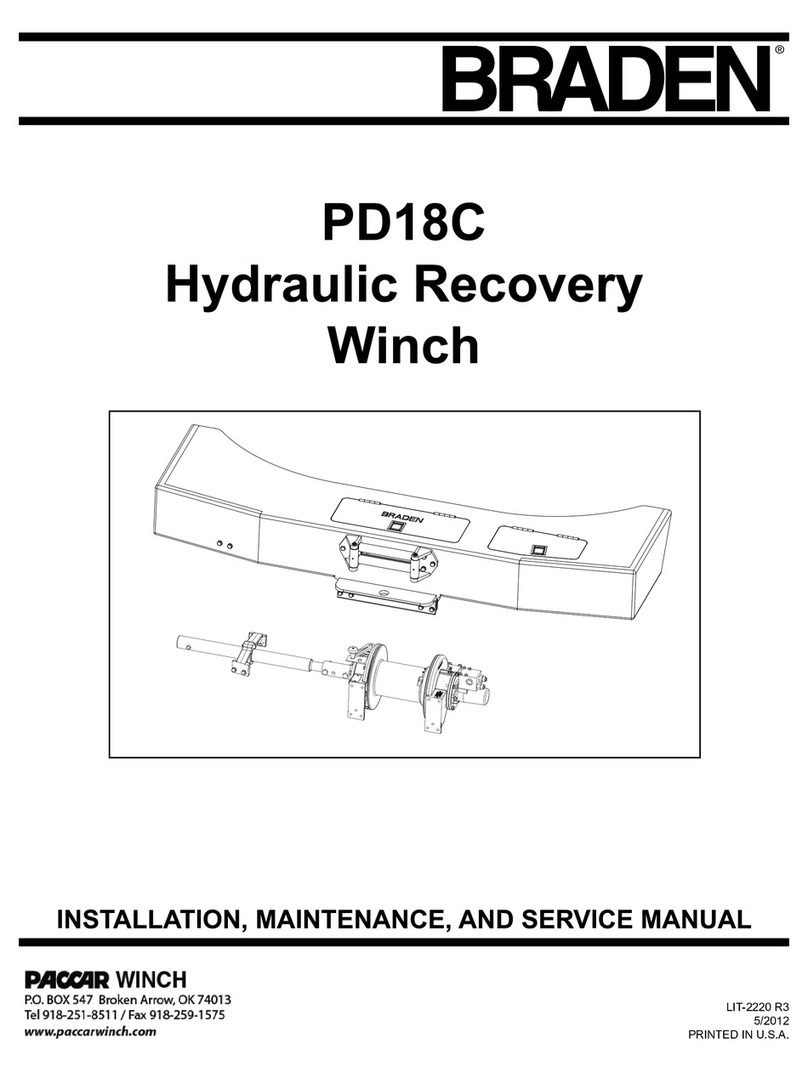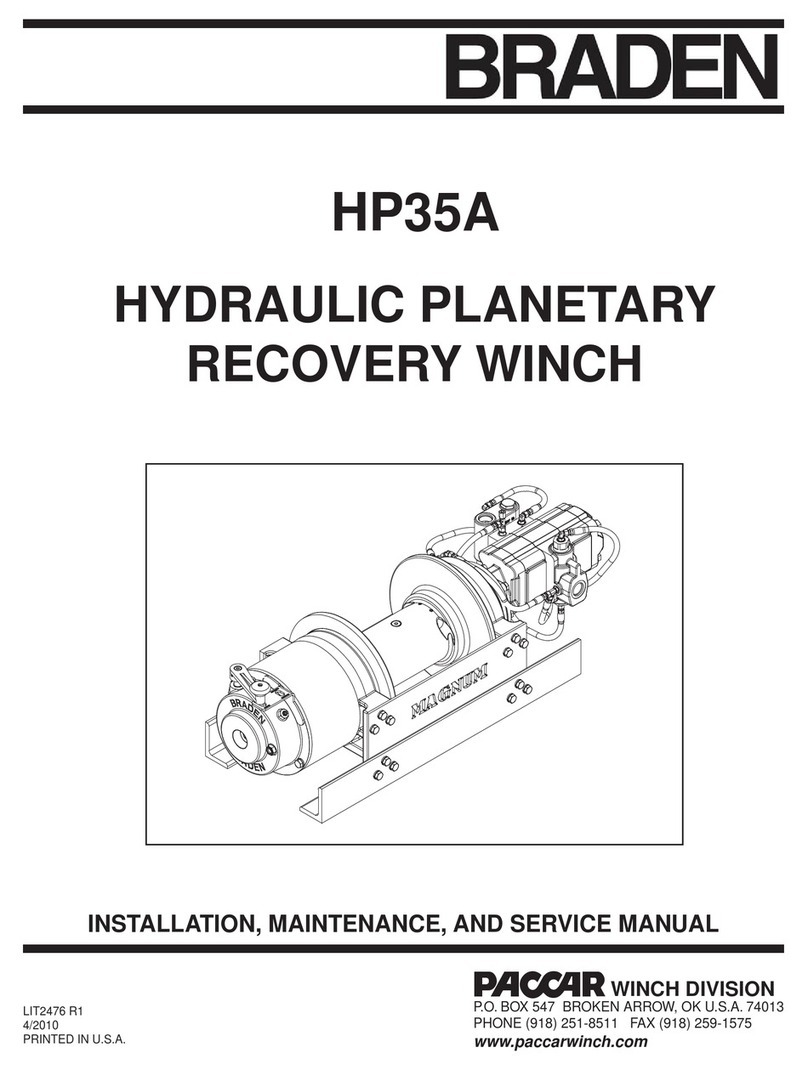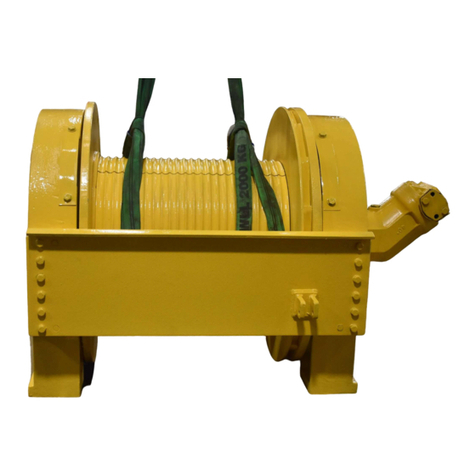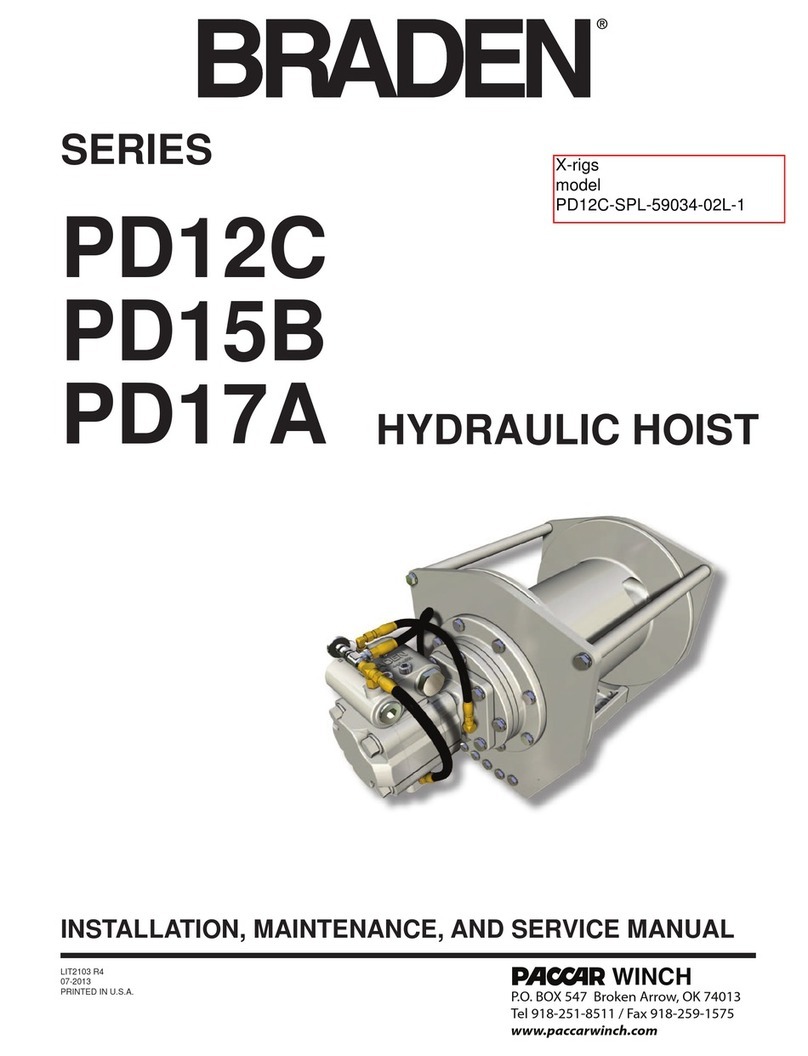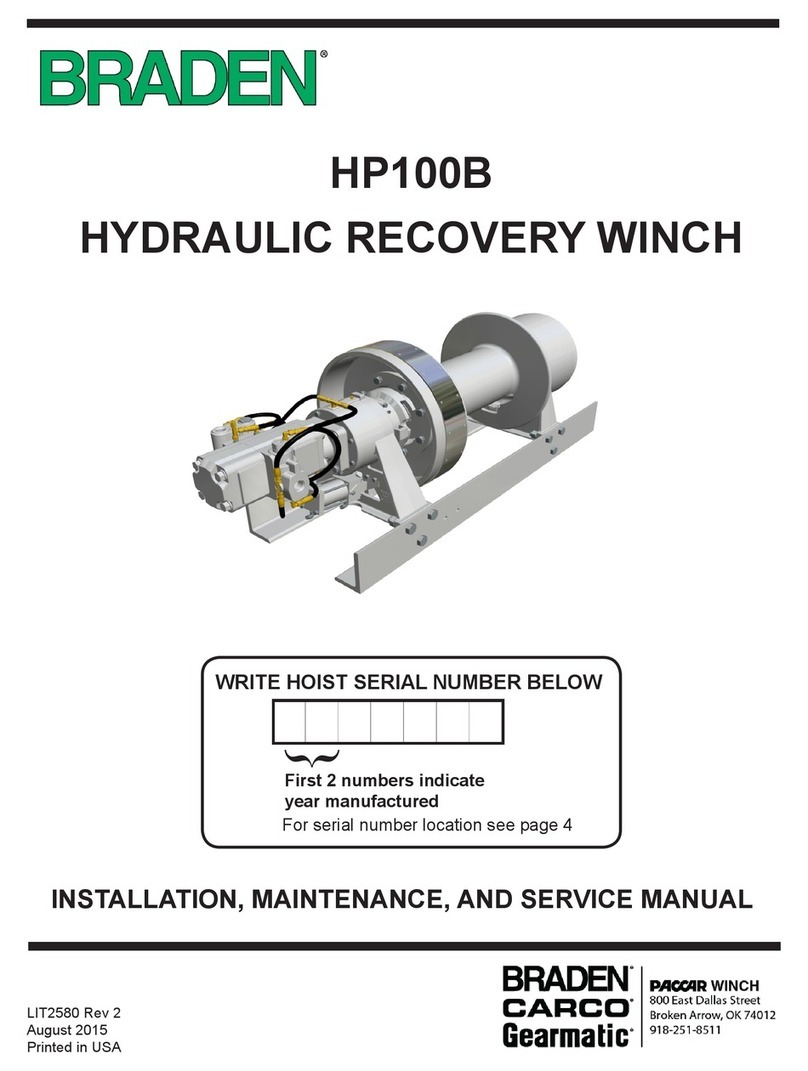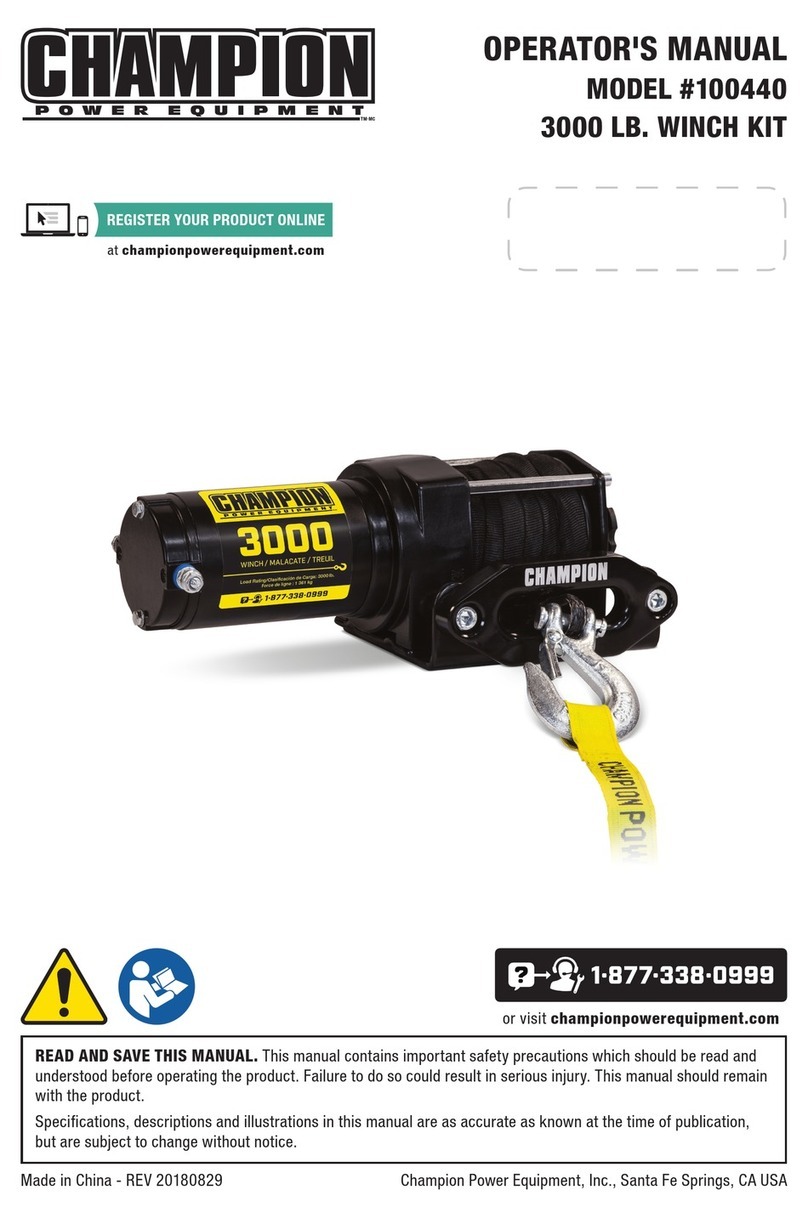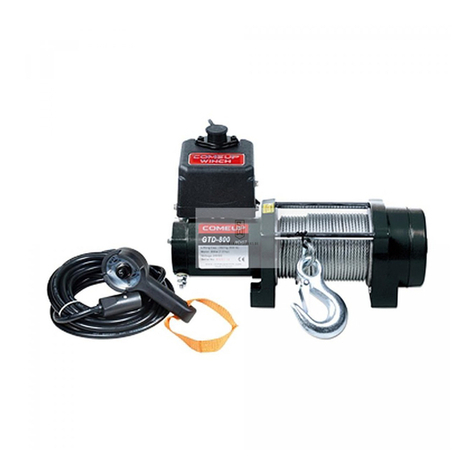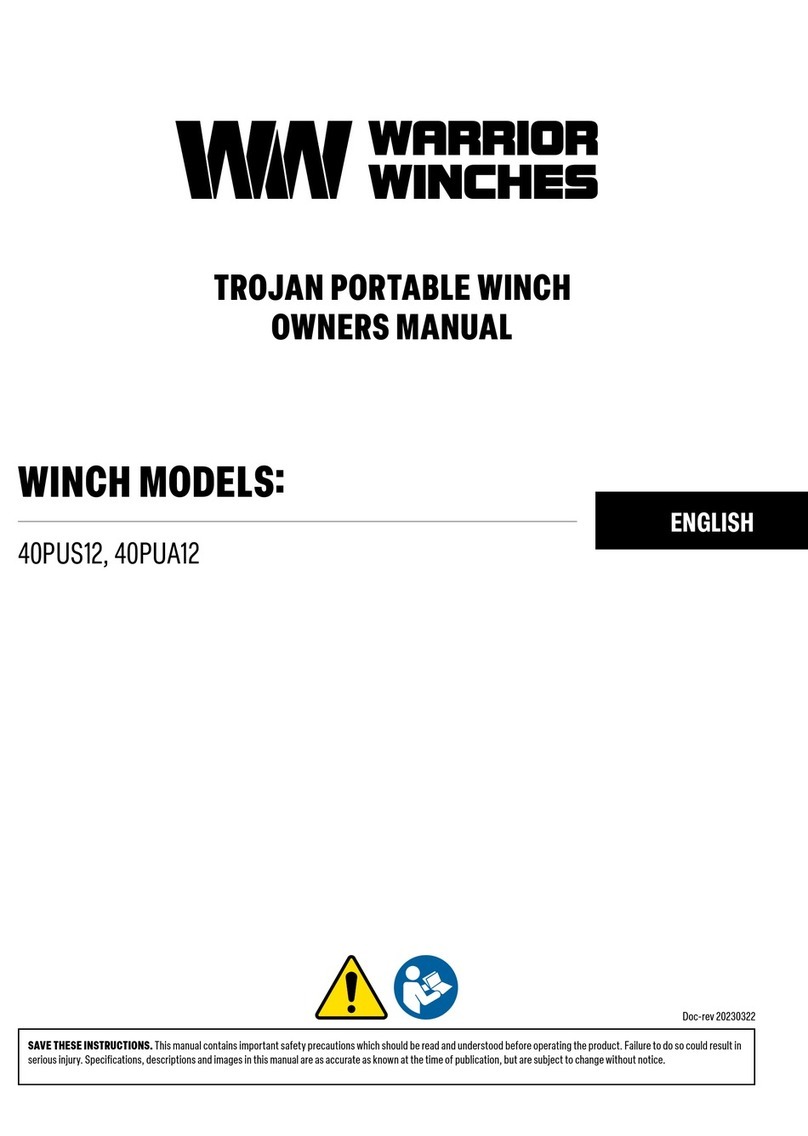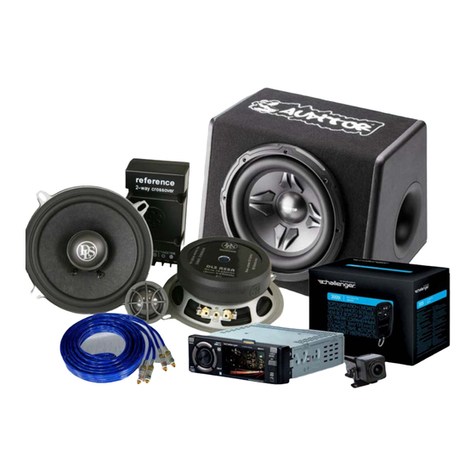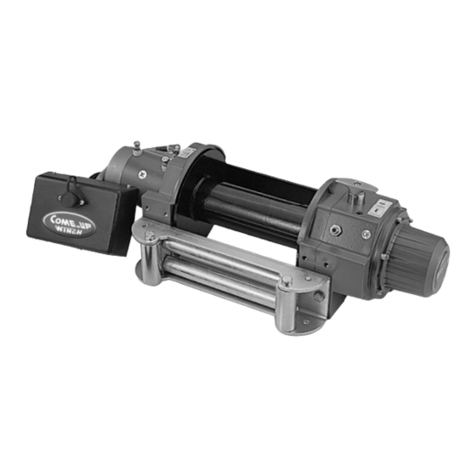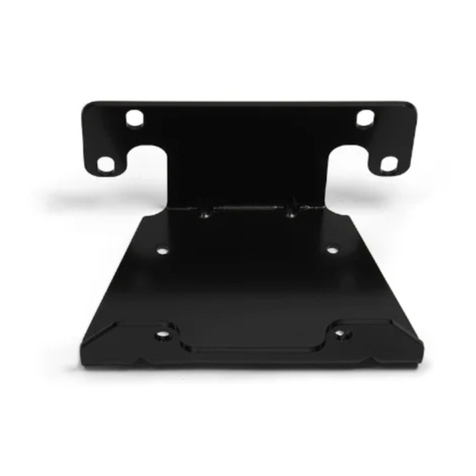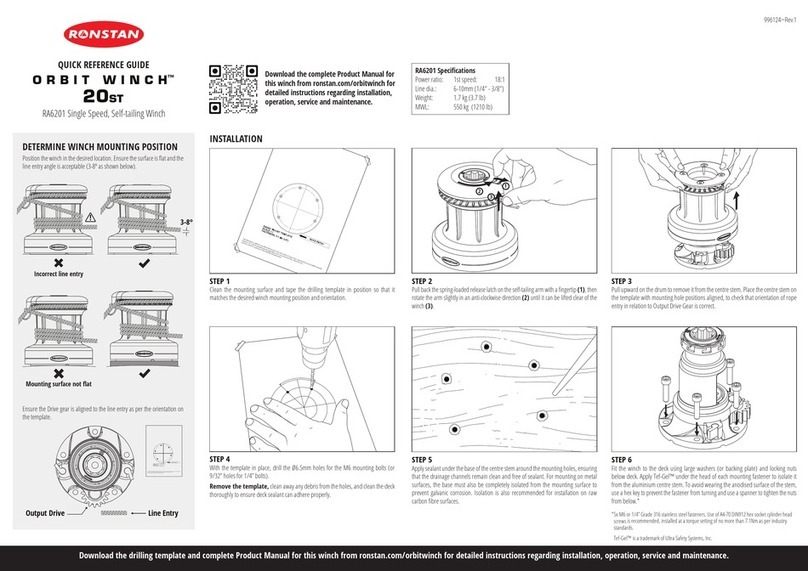BRADEN CH280 Manual

LIT2423 R7
November 2018
Printed in USA
©2018 PACCAR Inc.
All rights reserved
Visit our Web site at www.paccarwinch.com for the most comprehensive collection of winch, hoist, and drive
information on the Internet. Most publications and specification sheets are available for downloading.
WRITE HOIST SERIAL NUMBER BELOW
}
First 2 numbers indicate
year manufactured
For serial number location, see Page 4
CH210 and CH280
Planetary Hoist
INSTALLATION, MAINTENANCE,
AND SERVICE MANUAL
CH210
CH280

Table of Contents
Foreword ........................................................................................................ 3
Model Identication......................................................................................... 4
Explanation of Model Number ........................................................................ 4
General Safety Recommendations................................................................. 5
Basic Operation.............................................................................................. 6
Hoist Installation ............................................................................................. 8
Wire Rope Installation .................................................................................... 8
Hydraulic Circuit ........................................................................................... 10
Preventive Maintenance................................................................................11
Recommended Gear Oil............................................................................... 12
Inspection, Testing Procedure ...................................................................... 13
Troubleshooting............................................................................................ 16
Exploded-view Drawings .............................................................................. 20
List of Components....................................................................................... 21
Hoist Disassembly........................................................................................ 24
Planet Carrier Service .................................................................................. 26
Overrunning Clutch Service.......................................................................... 30
Brake Cylinder Service................................................................................. 31
Hoist Assembly............................................................................................. 34
Recommended Bolt Torque .......................................................................... 35
Brake Valve Service ..................................................................................... 36
Metric Conversion Table ............................................................................... 39

3
Managing Waste
PACCAR Winch believes in a life-cycle approach to our products. We encourage best practices regarding “Going
Green” — making environmentally responsible decisions to “reduce, reuse, and recycle.”
• At the end of the winch’s useful life, it is highly recommended to drain and recycle any oil remaining in the equipment.
• Please use a metal recycler for winch disposal to reduce landll waste.
The U.S. Environmental Protection Agency has developed required practices, called “management standards,” for busi-
nesses that handle used oil and metal wastes. Specic guidelines are available at the EPA and API Web sites as well
as your state’s environmental agency Web site:
• https://www.epa.gov/
• http://recycleoil.org/
FOREWORD
The following service instructions have been prepared to provide assembly, disassembly and maintenance information
for the BRADEN Model CH Series 3 hoist. It is suggested that before doing any work on these units, all assembly and
disassembly instructions should be read and understood.
Some pictures in this manual may show details or attachments that are dierent from your hoist. Also, some compo-
nents have been removed for illustrative purposes.
Continuing product improvement may cause changes in your hoist, which are not included in this manual. Whenever
a question arises regarding your BRADEN Hoist or this manual, please contact BRADEN Service Department for the
latest available information.

4
CH Construction hoist
210 21,000–lb. rst-layer line pull
AModel series relating to design changes
36 Total gear reduction
110 Hydraulic motor displacement in cubic inches/revolution (decimal point eliminated,
example: 110–11.0 cubic inches/revolution)
01 Drum option
1Permits testing and inspection per API 2C for oshore cranes
Model number
and
Serial number
MODEL NUMBER AND SERIAL NUMBER
When information on a hoist is needed, always refer to
the model number and serial number. Both are located
on the top of the motor-side end plate as indicated above.
EXPLANATION OF MODEL NUMBER
CH 210 A - 36 110 - 01 - 1
Construction
Hoist
Max
Rating
Design
Model
Gear
Ratio
Motor
Size
Drum
Size
Option
MODEL IDENTIFICATION

5
GENERAL SAFETY RECOMMENDATIONS
Safety for operators and ground personnel is of prime
concern. Always take the necessary precautions to en-
sure safety to others as well as yourself. To ensure safety,
the prime mover and hoist must be operated with care and
concern by the operator for the equipment, and a thorough
knowledge of the machine’s performance capabilities. The
following recommendations are oered as a general safe-
ty guide. Local rules and regulations will also apply.
1. Read all warning tag information and become familiar
with all controls before operating hoist.
2. Never attempt to clean, oil or perform any mainte-
nance on a machine with the engine running, unless
instructed to do so in the service manual.
3. Never operate hoist controls unless you are properly
seated at the operators station on the prime mover and
you are sure personnel are clear of the work area.
4. Assure that personnel who are responsible for hand
signals are clearly visible and that the signals to be
used are thoroughly understood by everyone.
5. Ground personnel should stay in view of the prime
mover operator and clear of hoist drum. Do not allow
ground personnel near hoist line under tension. A safe
distance of at least 1.5 times the length of the cable
should be maintained.
6. On machines having hydraulically, mechanically and/
or cable controlled equipment, be certain the equip-
ment is either lowered to the ground or blocked se-
curely before servicing, adjusting and/or repairing the
hoist. Always apply the prime mover parking brakes
and lower equipment before dismounting the prime
mover.
7. Inspect rigging, hoist and hydraulic hoses at the begin-
ning of each work shift. Correct defects immediately.
8. Keep equipment in good operating condition. Perform
scheduled servicing and adjustments listed in the Pre-
ventive Maintenance section of this manual.
9. An equipment warm-up procedure is recommended
for all start-ups and is essential at ambient tempera-
tures below +40°F (4°C). Refer to the Warm-up Pro-
cedure listed in the Preventive Maintenance section of
this manual.
10. Be sure of equipment stability before operating hoist.
11. The hoists described herein are neither designed nor
intended for use or application to equipment used in
the lifting or moving of persons.
12. Do not exceed the maximum pressure (PSI or bar) or
ow (GPM or LPM) stated in the hoist specications.
13. Operate hoist line speeds to match job conditions.
14. Leather gloves should be used when handling hoist
cable.
15. Never attempt to handle hoist cable when the hook
end is not free.
16. When winding hoist cable on the hoist drum, never
attempt to maintain tension by allowing hoist cable to
slip through hands. Always use the hand-over-hand
technique.
17. Never use hoist cable with broken strands. Replace
hoist cable.
18. Do not weld on any part of the hoist.
19. Do not use knots to secure or attach hoist cable.
20. Use recommended hydraulic oil and gear lubricant.
21. Keep hydraulic system clean and free from contami-
nation at all times.
22. Use correct size cable anchor for cable and pocket in
hoist drum.
23. The BRADEN wire rope anchors supplied with CH210
hoists are not designed to support the rated load of
the hoist. ALWAYS maintain a minimum of ve wraps
of wire rope on the drum.
Safety Informational callouts used in this manual include:
WARNING — This emblem is used to warn against
hazards and unsafe practices which COULD result in
severe personal injury or death if proper procedures are
not followed.
Failure to obey the following safety recommendations
may result in property damage, personal injury, or death.
CAUTION — This emblem is used to warn against po-
tential or unsafe practices which COULD result in per-
sonal injury and property damage if proper procedures
are not followed.
CAUTION
!
!

6
BASIC OPERATION
DESCRIPTION OF HOIST
The hoist is made up of the following subassemblies:
1. Hydraulic motor and brake valve
2. Drum, drum closure, ball bearings and oil seals
3. Support end plate and bearing support
4. Motor end plate and motor adapter
5. Tie plates
6. Brake clutch assembly
7. Brake cylinder assembly and multiple-disc brake parts
8. Primary, second stage and output planetary reducer
assemblies
9. Ring gear
THEORY OF OPERATION
The primary sun gear is directly coupled to the hydraulic
motor by the inner race of the brake clutch assembly. As
the motor turns in the hoisting direction, the two planetary
assemblies reduce the input speed of the motor and rotate
the planetary gearing and the cable drum. The ring gear is
held stationary by the brake cylinder and the output planet
carrier is coupled directly to the cable drum causing the
drum to rotate in the same direction as the motor shaft.
In the hoisting direction, the static brake remains applied
and the input shaft rotates freely through the brake clutch.
When the motor is stopped, the load tries to rotate the
hoist gear train in the opposite direction. The brake clutch
immediately locks up, allowing the fully applied static
brake to hold the load rm. See “Dual Brake System –
Operation” for a detailed description of the sequence of
operation in the lowering direction.
Dual Brake System – Description
The dual brake system consists of a dynamic brake sys-
tem and a static brake system.
The dynamic brake system has two operating compo-
nents:
1. Brake valve assembly
2. Hydraulic motor
The brake valve is basically a counterbalance valve. It
contains a check valve to allow free ow of oil to the motor
in the hoisting direction and a pilot operated, spring-load-
ed spool valve that blocks the ow of oil out of the motor
when the control valve is placed in neutral. When the con-
trol valve is placed in the lowering position, the spool valve
remains closed until sucient pilot pressure is applied to
the end of the spool to shift it against spring pressure and
open a passage. After the spool valve cracks open, the pi-
lot pressure becomes ow-dependent and modulates the
spool valve opening which controls the lowering speed.
See Figures 2, 3, and 4.
The static brake system has three operating compo-
nents:
1. Spring-applied, multiple friction-disc static brake
2. Brake clutch assembly
3. Hydraulic piston and cylinder
Figure 2
Low Pressure Medium Pressure High Pressure
Pump
Control
Valve
Motor
Static
Brake
Brake
Valve
To
Tank
Figure 3
Low Pressure Medium Pressure High Pressure
Pump
Control
Valve
Motor
Static
Brake
Brake
Valve
To
Tank
Figure 4
Low Pressure Medium Pressure High Pressure
Pump
Control
Valve
Motor
Static
Brake
Brake
Valve
To
Tank

7
The static brake is released by the brake valve pilot pres-
sure at a pressure lower than that required to open the
pilot operated spool valve. This sequence assures that dy-
namic braking takes place in the brake valve and that little,
if any, heat is absorbed by the friction brake.
The friction brake is a load holding brake only and has
nothing to do with dynamic braking or rate of descent of
a load.
The brake clutch is splined to the primary sun gear shaft
between the motor and the primary sun gear. It will allow
this shaft to turn freely in the direction to raise a load and
lock up to force the brake discs to turn with the shaft in the
direction to lower a load (Figures 5 and 6).
The hydraulic cylinder, when pressurized, will release the
spring pressure on the brake discs, allowing the brake
discs to turn freely.
Dual Brake System – Operation
When hoisting a load, the brake clutch which connects
the motor shaft to the primary sun gear, allows free rota-
tion. The sprag cams lay over and permit the inner race
to turn free of the outer race (Figure 5). The friction brake
remains fully engaged. The hoist, in raising a load, is not
aected by any braking action (Figure 2).
When the lifting operation is stopped, the load attempts to
turn the primary sun gear in the opposite direction. This
reversed input causes the sprag cams to instantly roll up-
ward and rmly lock the shaft to the fully engaged friction
brake (Figure 6).
When the hoist is powered in reverse, to lower the load,
the motor cannot rotate until sucient pilot pressure is
present to open the brake valve (Figures 3 and 4). The
friction brake within the hoist will completely release at a
pressure lower than that required to open the brake valve.
The extent to which the brake valve opens will determine
the amount of oil that can ow through it and the speed
at which the load will be lowered. Increasing the ow of
oil to the hoist motor will cause the pressure to rise and
the opening in the brake valve to enlarge, speeding up
the descent of the load. Decreasing this ow causes the
pressure to lower and the opening in the brake valve to
decrease thus slowing the descent of the load.
When the control valve is shifted to neutral, the pressure
will drop and the brake valve will close, stopping the load.
The friction brake will engage and hold the load after the
brake valve has closed.
When lowering a load slowly for precise positioning, no
oil ow actually occurs through the hoist motor. The pres-
sure will build up to a point where the brake will release
suciently to allow the load to rotate the motor through its
own internal leakage. This feature results in a slow speed
and extremely accurate positioning.
The friction brake receives little wear in the lowering op-
eration. All of the heat generated by the lowering and stop-
ping of a load is absorbed by the hydraulic oil where it can
be readily dissipated.
Static Friction Brake Applied
Figure 5
Hoisting
Permits free
shaft rotation
while hoisting
Sprag
Cams
Static Friction Brake Applied
Figure 6
Stopped,
Holding
Load
Sprag
Cams
Load attempts to rotate shaft in opposite direction.
Brake clutch locks sun gear shaft to friction brake.

8
HOIST INSTALLATION
GENERAL REQUIREMENTS
1. The hoist should be mounted with the centerline of the
drum in a horizontal position. The mounting plane can
be rotated to any position around this centerline.
2. When mounting the CH210A hoist, BRADEN recom-
mends using 4 one-inch Grade 8 bolts and nuts, using
both mounting holes in each end plate. The CH280A
requires 1-1/4-inch bolts because the side plate hole is
1-3/8 inches.
3. It is important that the hoist be mounted on a surface
that will not ex when the hoist is in use, because this
could bind the working parts of the hoist. Also, be sure
the hoist is mounted on a at surface. If necessary, use
shim stock to ensure proper mounting. The mounting
surface should be at within ±0.020 inch (0.5 mm).
4. Hydraulic lines and components that operate the hoist
should be of sucient size to assure minimum back
pressure at the hoist. The gear motor manufacturer
recommends that the back pressure not exceed 100
PSI for maximum motor seal life. 150 PSI is the maxi-
mum allowable back pressure. The standard CH210A/
CH280 hoist is supplied with the motor internally
drained. If high back pressures are encountered, the
motor can be drained directly to tank to improve motor
seal life. To ensure adequate static brake load holding
ability, back pressure on the hoist should not exceed
150 PSI. For pressures exceeding 150 PSI, consult
BRADEN Engineering. For piston motors, the back
pressure must be 30 PSI.
5. Make certain that the hoist drum is centered behind the
rst sheave and the eet angle does not exceed 1.5
degrees. The hoist should also be mounted perpen-
dicular to an imaginary line from the center of the drum
to the rst sheave to ensure even spooling.
6. The hoist directional control valve must be a three-
position, four-way valve with a motor spool such that
when the valve is in the center position both work ports
are opened directly to tank.
7. The hydraulic oil lter should have a 10-micron nomi-
nal rating and be a full-ow type.
8. High-quality hydraulic oil is essential for satisfactory
performance and long hydraulic system component life.
Oil having 150 to 330 SUS viscosity at 100°F (38°C)
and viscosity index of 100 or greater will give good re-
sults under normal temperature conditions. The use of
an oil having a high viscosity index will minimize cold-
start trouble and reduce the length of warm-up periods.
A high viscosity index will minimize changes in viscos-
ity with corresponding changes in temperature.
Maximum cold weather start-up viscosity should not
exceed 5,000 SUS with a pour point at least 20°F (7°C)
lower than the minimum temperature.
Under continuous operating conditions, the tempera-
ture of the oil at any point in the system must not ex-
ceed 180°F (82°C). A temperature between 120–140°F
(49–60°C) is generally considered optimum.
In general terms: For continuous operation at ambi-
ent temperatures between 50–110°F (10–43°C), use
SAE 20W. For continuous operation between 10–90°F
(50–32°C), use SAE 10W. For applications colder than
10°F (12°C), contact the BRADEN Service Depart-
ment. The use of multiviscosity oils is generally not
recommended.
DO NOT weld hoist to mounting surface. Welding may not
provide adequate structural support for hoist loads. This
may cause loss of load control, which could result in prop-
erty damage, injury, or death. Welding may also damage
bearings and seals, resulting in premature failure.
WIRE ROPE INSTALLATION
The wedge and anchor pocket must be clean and dry. The
end of the wire rope being anchored to the drum must be
clean and dry and not frayed. Anything on the end of the
wire rope to keep it from fraying (tape or wire) must not
be in contact with the wedge when the installation is com-
plete. Consult the wire rope manufacturer on the proper
treatment of the dead end of the wire rope. Some rope
manufacturers recommend when using rotation-resistant
wire rope, that the rope end be seized, welded, or brazed
before inserting the wire rope into the wedge socket. This
prevents core slippage or loss of rope lay.
Take the free end of the wire rope and insert it through the
small opening on the cable drum. Loop the wire rope and
push the free end about 3/4 of the way back through the
pocket. Install the wedge as shown in Figure 7, then pull
the slack out of the wire rope. The dead end of the rope
needs to extend slightly beyond the end of the wedge as
shown in Figure 8.
THE CABLE ANCHORS ALONE ON HOISTS ARE
NOT DESIGNED TO HOLD RATED LOADS. Hoist
loads applied directly to the wire rope anchor may
cause the wire rope to pull free and result in the sudden
loss of load control and cause property damage, injury,
or death. A minimum of 5 wraps of wire rope must be left
on the drum barrel to achieve rated load.

9
Using a hammer and brass drift, drive the wedge as deep
into the pocket as possible to ensure it is fully seated and
no further movement is detected. Applying a load on the
wire rope will also help seat the wedge in the pocket.
Check to ensure the wedge does not protrude from either
end of the pocket, causing it to interfere with proper spool-
ing of wire rope onto the drum (Figures 9 and 10). If there
is interference or the wedge does not seat rmly, contact
the BRADEN Product Support Department at 918-251-
8511 to determine the proper wedge size.
It is important that the wire rope have the proper tension-
ing when it is installed on the drum. When the wire rope
is rst installed, you should operate the hoist, with light to
moderate loads, with reeving that let’s you place these
loads on the block and the drum with all the rope o the
drum except for the last three wraps.
HOIST MODEL
CH210A..........................................
CH280A..........................................
WEDGE PART NO.
24493* for 1/2 through 3/4 inch (13–19 mm)
24494* for 7/8 through 1 inch (22–25 mm)
24493 for 3/4 inch (19 mm)
Incorrect Installation
WIRE ROPE WEDGE PART NUMBERS
*Standard Anchor
Correct Installation
Figure 7 Figure 8
Wedge and wire rope
fully seated in pocket
Drive from
this side
Figure 9
Wedge not
fully seated
• Wire rope not tight against wedge
• Wedge may be too large • Dead end of wire rope and/or wedge may inter-
fere with proper spooling
• Wedge may be too small
Figure 10
Wedge pulled too far
through anchor pocket

10
HYDRAULIC CIRCUIT
HOIST BRAKE
BRAKE
VALVE
PUMP
CONTROL
VALVE
HOIST ASSEMBL
Y
W/BRAKE VALVE
& STATIC BRAKE
BR
DR
SINGLE-SPEED MOTOR CIRCUIT
HOIST BRAKE
BRAKE
VALVE
2-SPEED
SELECTOR
VALVE
PUMP
CONTROL
VALVE
HOIST ASSEMBLY
W/BRAKE VALVE
& STATIC BRAKE
TP
BR
DR
A
TWO-SPEED MOTOR CIRCUIT
HOIST BRAKE
BRAKE
VALVE
PUMP
CONTROL
VALVE
HOIST ASSEMBL
Y
W/BRAKE VALVE
& STATIC BRAKE
BR
DR
WITH AUXILIARY BRAKE

11
PREVENTIVE MAINTENANCE
A regular program of preventive maintenance for your
planetary hoist is strongly recommended to minimize the
need for emergency servicing and promote safe, reliable
hoist operation.
Initially, the gear oil should be changed after the rst 100
hours of operation.
1. Vent Plug and Oil Level
The vent plug and oil level sight gauge are located in the
bearing support on the end of the hoist opposite the motor.
It is important to keep the vent clean and unobstructed.
Whenever gear oil is changed, remove the vent plug and
sight gauge, clean in solvent and reinstall.
Do not paint over the vent or replace with a solid plug.
2. Oil Change
Rotate the drum to align the drain plug with the lowest
hole in the support bracket. Install a short piece of 1-inch
pipe into the threads around the drain plug. Remove the
drain plug (5/16-inch hex) and drain the oil into a suitable
container. Always dispose of used oil in an environmental-
ly responsible manner. Remove the 1-inch pipe and rotate
the drum to align the hole in the drum with the highest hole
in the support bracket. Reinstall the pipe and ll the hoist
drum with the recommended oil to the center of the sight
gauge. Install the drain plug and remove the pipe.
3. Hydraulic System
The original lter element should be replaced after the rst
50 hours of operation, then every 500 operating hours or
three months, or in accordance with the equipment manu-
facturer’s recommendations.
4. Wire Rope
Inspect entire length of wire rope according to wire rope
manufacturer’s recommendations.
5. Mounting Bolts
Tighten all hoist base mounting bolts to recommended
torque after the rst 100 hours of operation, then every
1,000 operating hours or six months, whichever occurs rst.
6. Warm-up Procedures
A warm-up procedure is recommended at each start-up
and is essential at ambient temperatures below +40°F
(4°C).
The prime mover should be run at its lowest recommended
RPM with the hydraulic hoist control valve in neutral,
allowing sucient time to warm up the system. The hoist
should then be operated at low speeds, forward and
reverse, several times to prime all lines with warm hydraulic
oil, and to circulate gear lubricant through the planetary
gear sets.
7. Recommended Planetary Gear Oil
Field experience, supported by engineering endurance
tests, indicates use of the proper gear oil and a program of
regular preventive maintenance will help provide extended
gear train life and reliable hoist brake performance. Refer
to Recommended Gear Oil, later in this section.
For simplicity, BRADEN has listed available products in
each temperature range that have been tested and found
to meet our specifications. This is not to say that other
lubricant brands would not perform equally as well.
If the following lubricant brands are not available in your
area, make certain your lubricant vendor supplies you
with oil equivalent to those products listed on following
page..
Failure to properly warm up the hoist, particularly un-
der low ambient temperature conditions, may result in
temporary brake slippage due to high back pressures
attempting to release the brake, which could result in
property damage, severe personal injury, or death.
Failure to use the proper type and viscosity of planetary
gear oil may contribute to intermittent brake clutch slip-
page which could result in property damage, severe
personal injury, or death. Some gear lubricants contain
large amounts of extreme-pressure (EP) and antifric-
tion additives which may contribute to brake slippage
and damage to brake friction discs or seals. Oil viscos-
ity with regard to ambient temperature is also critical to
reliable brake operation. Our tests indicate that exces-
sively heavy or thick gear oil may contribute to inter-
mittent brake slippage. Make certain that the gear oil
viscosity used in your hoist is correct for your prevailing
ambient temperature.
Oil Level
Sight Gauge
Oil Drain
Hole(s)
Vent Plug

12
Unless otherwise specified, it is recommended gear oil be changed after the first 100 hours or two months of machine
operation, then every 1,000 hours or six months, whichever occurs first. The gear oil should also be changed when-
ever the ambient temperature changes significantly and an oil from a different temperature range would be more
appropriate.
Failure to use the proper type and viscosity of planetary gear oil may contribute to intermittent brake clutch slippage,
which could result in property damage, severe personal injury, or death. Some gear lubricants contain large amounts
of extreme-pressure (EP) and antifriction additives which may contribute to brake clutch slippage or damage to brake
friction discs or seals. Oil viscosity, affected by ambient temperature, is also critical to reliable brake clutch operation.
Our tests indicate excessively heavy or thick gear oil may contribute to intermittent brake clutch slippage. Make certain
gear oil viscosity used in your hoist is correct for your prevailing ambient temperature.
PintsQuartsLitre
CH210-01 (before 7/2003)341716.1
CH210-01 (after 7/2003) 23 11.5 10.9
CH210-02 60 30 28.4
CH210-03G 36 18 17
CH210-05G 44 22 20.8
CH280A - 01 50 25 22.7
CH280A - 02 108 54 51
CH210/CH280 Planetary Hoist Oil Capacity
PREVAILING AMBIENT TEMPERATURE
oF -40 -30 -20 -10 0 10 20 30 40 50 60 70 80 90 100 110 120 130 oF
oC -40 -30 -20 -10 0 10 20 30 40 50 oC
SHADED TEMPERATURE RANGE IN THE CHART ABOVE NOT RECOMMENDED FOR SEVERE APPLICATIONS SUCH AS SUSTAINED
FAST DUTY CYCLES OR FREQUENT WINCHING.
TexacoShell
Meropa 220
Meropa 150
Omala S2 G 220
Omala S2 G 150
Chevron
Gear Compounds EP 220
Gear Compounds EP 150
PREVAILING AMBIENT TEMPERATURE
oF -40 -30 -20 -10 0 10 20 30 40 50 60 70 80 90 100 110 120 130 oF
oC -40 -30 -20 -10 0 10 20 30 40 50 oC
SHADED TEMPERATURE RANGE IN THE CHART ABOVE NOT RECOMMENDED FOR SEVERE APPLICATIONS SUCH AS
Mobil
Mobilgear 600 XP 220
Mobilgear 600 XP 150
Winches are factory filled with Mobilgear 600 XP 150 or equivalent. Consult your oil supplier for other equivalent
oils if required.
RECOMMENDED GEAR OIL
Omala S4 GX 150
Mobilgear SHC 150
Use gear oil detailed in Range A
Range A
Range B
Range C
Use gear oil detailed in Range B
Use gear oil detailed in Range C

13
Inspection, testing, and preventive maintenance requirements are divided into several categories: Pre-use, Quarterly,
Semiannual and Annual as outlined below. The Installation, Maintenance, and Service Manual for each model provides
specic instructions for maintenance and service.
Some inspection intervals make reference to hoists used in severe-duty applications. Severe-duty applications are
where the hoist is operated more than 12 hours per day and/or for extended periods of time at or near the rated capac-
ity of the hoist.
Anytime that the hoist exhibits erratic operation and/or unusual noise(s), the hoist should be taken out of ser-
vice until it is inspected and serviced by a qualied technician.
REGULAR INSPECTION, TESTING, AND PREVENTIVE MAINTENANCE — Must include, but not be limited to the
following:
PRE-USE INSPECTION (each shift the hoist is used): Will be performed prior to placing the crane into service and
then as necessary during the day for extended operation.
1. Check for external oil leaks and repair as necessary. This is extremely important because of the accelerated
wear that can be caused by insucient lubricating oil in the hoist. Lubricant level must be maintained between
the maximum and minimum levels. Use only the recommended type of lubricant; see service manual for details. On
models without a sight glass, check oil level monthly.
2. Check the ratchet and pawl mechanism (if so equipped) for proper operation and for full engagement of the pawl with
the ratchet wheel. Repair and/or adjust as necessary.
3. Check hydraulic plumbing for damage, such as chafed or deteriorated hoses, and repair as necessary.
4. Visually inspect for loose or missing bolts, pins, keepers or cotter pins and replace or tighten as necessary.
QUARTERLY INSPECTION (every 3 months) or monthly in severe-duty applications or prior to putting the machine
into service if it has not been used for 3 months or more. Documentation of the inspections must be kept with the hoist/
crane for a minimum of two years from the date of the inspection (see Page 3).
Perform the PRE-USE INSPECTION plus the following:
1. Check the lubricant level in the hoist(s) and maintain it between maximum and minimum levels. Use only recom-
mended type of lubricant; see service manual for details.
2. On hoists used for personnel handling, the internal spring-applied brake shall be tested in accordance with the pro-
cedure on Page 6 of publication PB-308.
3. Inspect for corrosion of fasteners, mounting base, drum, etc. and repair/replace as necessary.
SEMIANNUAL INSPECTION (every six months),or quarterly in severe-duty applications. Documentation of the
inspections must be kept with the hoist/crane for a minimum of two years from the date of the inspection (see next
page).
Perform the PRE-USE INSPECTION and QUARTERLY INSPECTION plus the following:
Take a sample of the lubricating oil from the hoist drum, following the oil sampling procedure on Page 5 of publication
PB-308, and analyze it for wear metals content, the correct viscosity, signs of overheating, water and other contami-
nates. If the oil sample contains an unusual amount of metallic particles, the hoist should be taken out of service and
undergo a teardown inspection. The oil sample must be taken prior to changing the lubricating oil. The semiannual
oil analysis can be omitted if the crane has been used less than 250 hours since the previous oil sample.
ANNUAL INSPECTION, Testing, and Preventive Maintenance or semiannually in severe-duty applications. Docu-
mentation of the inspections must be kept with the hoist/crane for a minimum of two years from the date of the inspec-
tion (see next page). The annual inspection must include, but not be limited to the following:
1.Perform the PRE-USE INSPECTION, QUARTERLY, and SEMIANNUAL INSPECTIONS, plus the following:
2.Change lubricating oil in hoist drum or gearbox after oil sample is taken. Refer to Recommended Gear Oil, earlier in
this section. Failure to follow these recommendations may result in brake failure.
BRADEN recommends the following inspection, testing, and preventive maintenance procedures.
For additional details, refer to BRADEN publication PB-308.

14
NOTE: If the oil sampling/analysis has not been performed as required, refer to the teardown inspection
section below.
The user of BRADEN products is responsible for hoist inspection, testing and maintenance noted above with frequency
dependent upon the severity of the hoist duty cycle and the thoroughness of the preventive maintenance program in
eect.
Alternate inspection periods may be used if approved in writing by BRADEN. Those that are interested in an alter-
nate inspection period should submit a written proposal to BRADEN that includes typical duty cycle for the hoist along
with a detailed description of the preventive maintenance program for these hoists.
Inspection Records and Retention
Crane inspection reports as well as records of preventive maintenance, repairs and modications to hoists should be
available and accessible for a minimum of two years. These records should include, but not be limited to, hoist model
and serial number, name and employer of repair/inspection technician, date and description of preventive maintenance,
functional test reports and repairs.
To provide customers with qualied outlets for hoist service and repairs, BRADEN has established authorized Service
Centers. These Service Centers have factory trained service technicians, up-to-date service information, extensive
parts inventories, complete testing facilities, and are audited by BRADEN on a regular basis for compliance. BRADEN
strongly recommends the use of BRADEN authorized Service Centers for maintenance, repair and inspection of
BRADEN/Gearmatic products. Contact the BRADEN Product Support Department at 918-251-8511 for the names of
current authorized Service Centers.
TEARDOWN INSPECTION – Any Hoist that has NOT been subject to regular oil sample analysis should un-
dergo a teardown inspection on an annual (12-month) basis. Also, if a hoist has an unknown history of repair and/
or maintenance, it is recommended that the hoist undergo a teardown inspection prior to it being placed into service.
A teardown inspection should include the hoist being completely disassembled, cleaned and inspected and replace-
ment of all worn, cracked, corroded or distorted parts such as pins, bearings, shafts, gears, brake rotors, brake plates,
drum and base. Refer to the applicable BRADEN or Gearmatic Service Manual for more details. All seals and O-rings
should be replaced during a teardown inspection.
Any deciencies, such as those listed above shall be corrected immediately.
All of the following operations must be performed before the hoist is placed back in service:
The rebuilt hoist must be line pull tested to the rated load of the hoist (hoist rating will vary with motor, gear ratio and
drum options) with a dynamometer or equivalent measuring device. This test load should be the maximum rating for
the hoist for the specic application (at the normal hydraulic relief valve setting for the hoist), not the reduced rating for
personnel lifting.
The hoist must be dynamically tested by rotating the drum several times, in both the hoisting and lowering directions,
while under a load of at least 30% of the hoist lifting capacity. Check for smooth operation during this procedure.
The brake should be tested per the brake test procedures on Page 6 of Publication PB-308.
After inspection or rebuild and testing, a new certicate for personnel handling will be issued by the inspector/ service
technician eective on the date the hoist is placed back in service.
See sample inspection certicate on next page.

15
PERSONNEL HANDLING
BRADEN recognizes that most hoists and cranes are designed and intended for handling materials and not personnel.
The crane or hoist is to be used to handle personnel only if it can be shown there is no less hazardous way
of carrying out the job. In these situations, all safety precautions must be strictly adhered to. BRADEN recommends
adherence to the latest revision of API 2D (RP 2D) and/or ANSI/ASME standard B30.5 and/or OSHA and/or other ap-
plicable standards for your application. It is important that you obtain a copy of all applicable safety standards, and that
you read and understand them prior to using the hoist. In addition to, or in conjunction with, the applicable standards,
BRADEN requires the following:
• The hoist must be maintained in accordance with the recommendations in this document and the service proce-
dures in the Installation, Maintenance, and Service Manual for your specic hoist.
• When handling personnel, the allowable line pull will be limited to 30% of the hoist rated line pull. This reduction
increases the hoist design factor from 3:1 to 10:1, approximately. Example: a hoist rated at 15,000 lbs. on the rst
layer will be rated at 15,000 x 0.3 = 4,500 lbs. on the rst layer when handling personnel.
• Personnel are permitted to ride in an approved personnel platform only as described in API, OSHA or ANSI/ASME
standards.
• The crane must be in good working order and equipped with all required safety equipment, including an anti two-
blocking device or warning signal and a boom angle and length indicator. Two-blocking occurs when the load block
or hook assembly comes in contact with the upper block or point sheave assembly and often results in damage to
the wire rope, rigging and/or hoist.
• Personnel being lifted or supported shall wear safety belts with lanyards attached to designated points unless lifting
over water. If lifting over water, provide approved personal otation devices (PFD).
• The lifting and supporting shall be made under controlled conditions and under the direction of an appointed signal
person.
• The operator and signal person shall conduct a test lift, without personnel in the personnel platform, to verify ad-
equacy of the crane footing or support. The crane outriggers, if so equipped, must be fully extended and properly
set.
• Cranes shall not travel (move locations) while personnel are on the personnel platform.
• The platform must be landed or tied o, and all brakes set before personnel enters or exits.
Name of Service Company
Approved by BRADEN for handling personnel
if used and maintained in accordance with BRADEN
Recommendations for Personnel Handling Hoists
Hoist Model No.: ____________________________
Hoist Serial No.: ____________________________
Date of Inspection: ____________________________
Work Order/Job No.: ____________________________
Inspector’s Name: ____________________________
For a copy of recommendations write or call: BRADEN
800 E. Dallas St., Broken Arrow, OK, 74012; (918) 251-8511
Sample inspection certicate

16
TROUBLESHOOTING
If a hoist ever exhibits any sign of erratic operation, or load control diculties (load creeping or chattering) appropriate
troubleshooting tests and repairs should be performed immediately. Continued operation in this manner may result in
property damage, serious personal injury, or death.
A
The hoist will not lower the load or
not lower the load smoothly.
1. The problem could be a plugged
or loose pilot orice. The pilot ori-
ce is a small pipe plug with a hole
drilled through it, located behind
the pilot port tting on the brake
valve. If it becomes plugged, it will
prevent the pilot pressure, from the
manifold, from opening the brake
valve. If it becomes loose, it will al-
low an unregulated amount of oil
in to operate the brake valve which
cause erratic brake valve opera-
tion.
Remove the pilot hose and tting from
the brake valve, then use a 5/32-inch
Allen wrench to remove the pilot ori-
ce. The diameter of the orice is ap-
proximately .020 inch. Clean and in-
stall the pilot orice tightly in the brake
valve.
2. The friction brake may not be re-
leasing as a result of a defective
brake cylinder seal.
NOTE: If the brake cylinder seal
is defective you will usually nd oil
leaking from the hoist vent plug.
Check brake cylinder seal as follows:
A. Disconnect the swivel tee from
the brake release port. Connect a
hand pump with accurate 0–2,000
PSI gauge and shut-o valve to
the –4 JIC tting in the brake re-
lease port.
B. Apply 1,000 PSI to the brake.
Close shut-o valve and let stand
for ve minutes.
C. If there is any loss of pressure in
ve minutes, the brake cylinder
should be disassembled for in-
spection of the sealing surfaces
and replacement of the seals. Re-
fer to Motor Support-Brake Cylin-
der Service section of manual.
3. Friction brake will not release as a
result of damaged brake discs.
Disassemble brake to inspect brake
discs. Check stack-up height as de-
scribed in Motor Support-Brake Cylin-
der Service section.
TROUBLE PROBABLE CAUSE REMEDY

17
TROUBLE PROBABLE CAUSE REMEDY
B
Oil leaks from vent plug 1. Same as A2.
2. Motor seal may be defective as a
result of high system back pres-
sure or contaminated oil.
Same as A2.
System back pressure must not ex-
ceed 150 PSI. Inspect hydraulic sys-
tem for a restriction in the return line
from the control valve to the reservoir.
Be sure control valve and plumbing is
properly sized to hoist motor.
Oil analysis may indicate contamina-
tion has worn motor shaft and seal.
Thoroughly ush entire hydraulic sys-
tem and install new lters and oil. In-
stall new motor seal.
C
The brake will not hold a load with
the control lever in neutral.
1. Excessive system back pressure
acting on the brake release port.
2. Friction brake will not hold due to
worn or damaged brake discs.
3. Brake clutch is slipping.
The same as Remedy 2 of Trouble
B2.
Same as Remedy 3 of Trouble A3.
Improper planetary gear oil may
cause the brake clutch to slip. Drain
old gear oil and ush hoist with sol-
vent. Thoroughly drain solvent and
rell hoist with recommended plane-
tary gear oil listed in Preventive Main-
tenance section of manual.
Brake clutch may be damaged or
worn. Disassemble and inspect brake
clutch as described in Brake Clutch
Service section.
D
The hoist will not raise the rated
load.
1. The hoist may be mounted on an
uneven or exible surface which
causes distortion of the hoist base
and binding of the gear train. Bind-
ing in the gear train will absorb
horsepower needed to hoist the
rated load and cause heat.
2. System relief valve may be set too
low. Relief valve needs adjustment
or repair.
Reinforce mounting surface.
If necessary, use shim stock to level
hoist. Refer to Hoist Installation sec-
tion.
First loosen, then evenly retighten all
hoist mounting bolts to recommended
torque.
Check relief pressure as follows:
A. Install an accurate 0–4,000 PSI
gauge into the inlet port of the
brake valve.

18
TROUBLE “D” CONTINUED FROM
PREVIOUS PAGE
The hoist will not raise the rated
load.
3. Be certain hydraulic system tem-
perature is not more than 180°F
(82°C). Excessive hydraulic oil
temperatures increase motor in-
ternal leakage and reduce motor
performance.
4. Hoist line pull rating is based on
rst layer of wire rope.
5. Rigging and sheaves not operating
eciently.
B. Apply a stall pull load on the hoist
while monitoring pressure.
C. Compare gauge reading to hoist
specications. Adjust relief valve
as required.
NOTE: If pressure does not increase
in proportion to adjustment, relief
valve may be contaminated or worn
out. In either case, the relief valve
may require disassembly or replace-
ment.
Same as remedies for Trouble D1
and D2.
Same as remedies for Trouble E2.
Refer to hoist performance charts for
additional information.
Perform rigging service as recom-
mended by crane manufacturer.
E
1. Same as D1.
2. Be certain that the hydraulic sys-
tem temperature is not more than
180°F. Excessive hydraulic oil
temperatures may be caused by:
A. Plugged heat exchanger.
B. Too low or too high oil level in hy-
draulic reservoir.
C. Same as D2.
D. Hydraulic pump not operating ef-
ciently.
3. Excessively worn or damaged in-
ternal hoist parts.
Same as remedies for Trouble D1.
Thoroughly clean exterior and ush
interior.
Fill/drain to proper level.
Same as remedies for Trouble D2.
Prime mover low on horsepower or
RPM Tune/adjust prime mover.
Check suction line for damage.
If pump is belt driven, belts are slip-
ping. Replace/tighten belts.
Pump worn. Replace pump.
Disassemble hoist to inspect/replace
worn parts.
TROUBLE PROBABLE CAUSE REMEDY

19
TROUBLE PROBABLE CAUSE REMEDY
F
Hoist chatters while raising rated
load.
1. Same as D2.
2. Hydraulic oil ow to motor may be
too low.
3. Controls being operated too quick-
ly.
Same as remedies for Trouble D2.
Same as remedies for Trouble E2.
Conduct operator training as re-
quired.
G
The wire rope does not spool
smoothly on the drum.
1. The hoist may be mounted too
close to the main sheave, causing
the eet angle to be more than 1.5
degrees.
2. The hoist may not be mounted per-
pendicular to an imaginary line be-
tween the center of the cable drum
and the rst sheave.
3. Could possibly be using the wrong
lay rope. There is a distinct advan-
tage in applying rope of the proper
direction of lay. When the load is
slacked o, the several coils on the
drum will stay closer together and
maintain an even layer. If rope of
improper lay is used, the coils will
spread apart each time the load is
removed. Then, when winding is
resumed, the rope has a tendency
to crisscross and overlap on the
drum. The result is apt to be a at-
tened and crushed rope.
4. The hoist may have been over-
loaded, causing permanent set in
the wire rope.
Check mounting distance and eet
angle. Reposition hoist as required.
Refer to Hoist Installation section of
manual.
Consult wire rope manufacturer for
recommendation of wire rope that
best suits your application.
Replace wire rope and conduct op-
erator/rigger training as required.

20
BRADEN CH210 COMPONENTS
Hoist Assembly
This manual suits for next models
1
Table of contents
Other BRADEN Winch manuals
Popular Winch manuals by other brands

Kolpin Outdoors
Kolpin Outdoors 25-1200 Assembly & owners manual
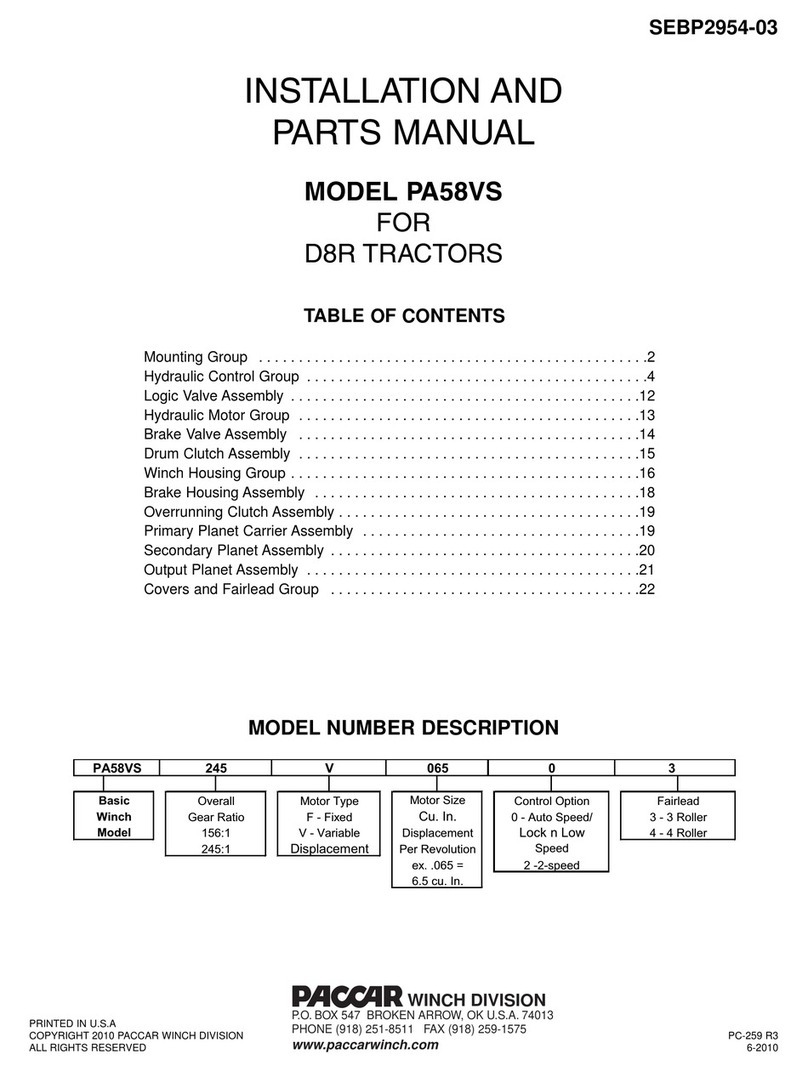
Paccar Winch
Paccar Winch PA58VS INSTALLATION AND PARTS MANUAL
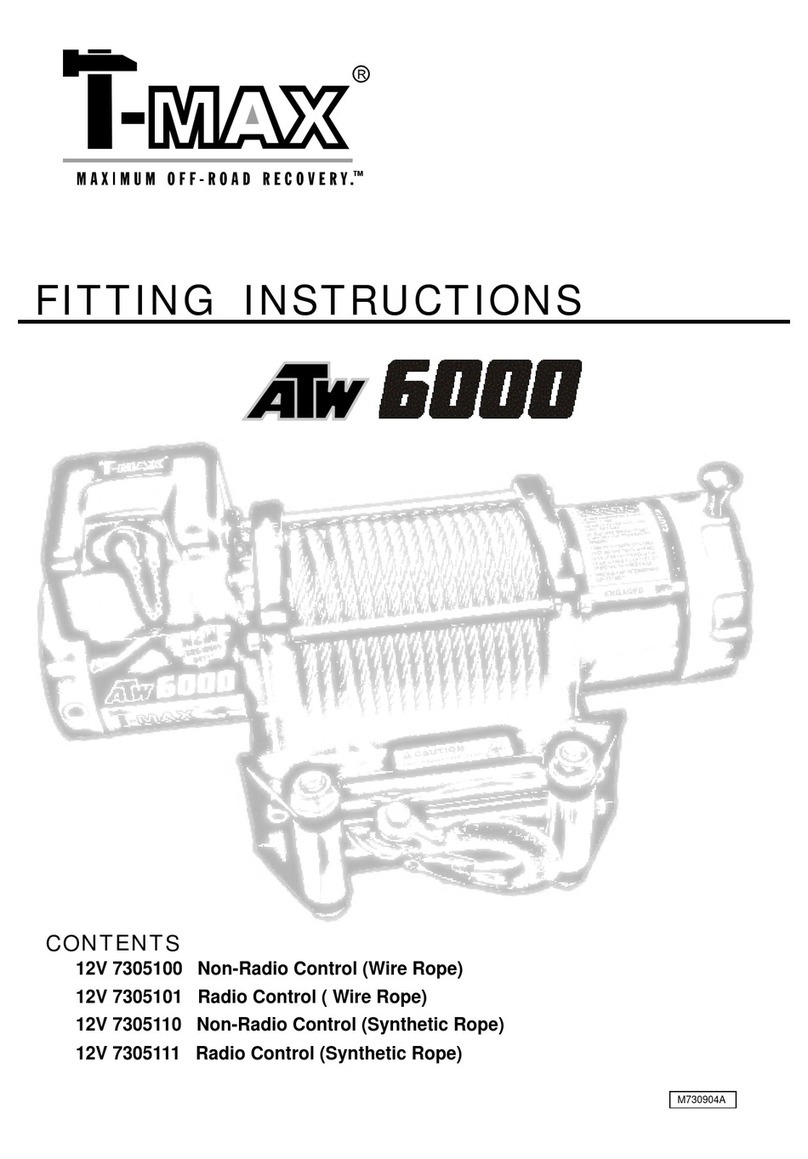
T-MAX
T-MAX ATW 6000 Fitting instructions

Ingersoll-Rand
Ingersoll-Rand LS1500R Parts and maintenance manual
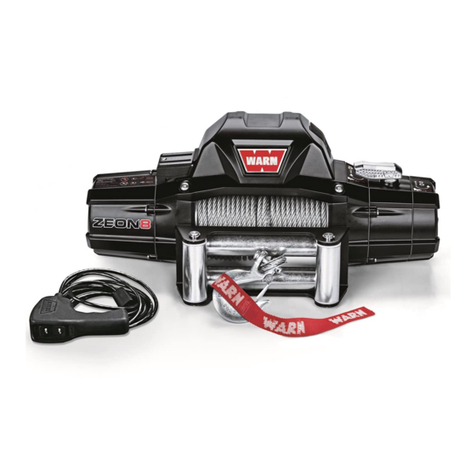
Warn
Warn ZEON-8 Service instructions

Harken
Harken 46.2 Parts and service instructions
